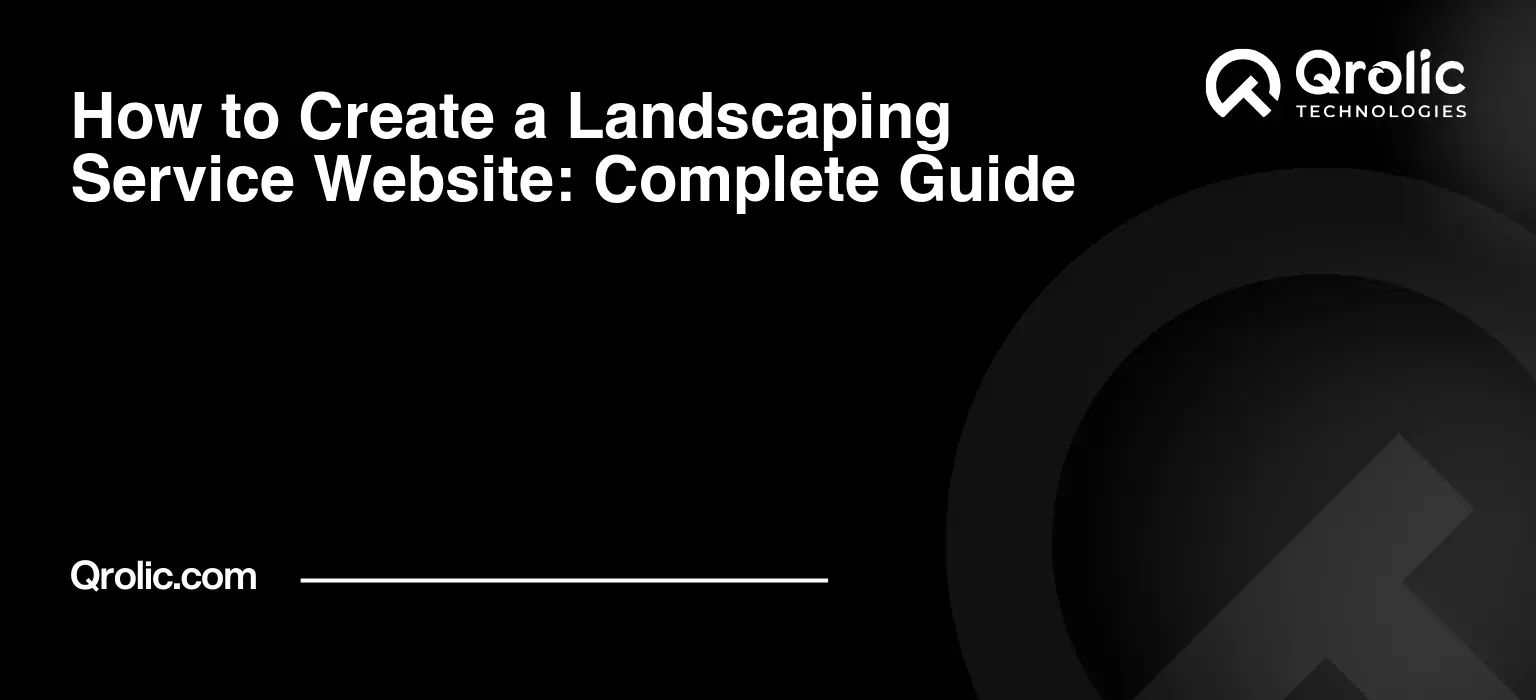Quick Summary:
- A website is key to attract clients and show work.
- Plan your site, choose WordPress, and add great visuals.
- Optimize for search engines and mobile users.
- Update content and track performance for growth.
Table of Contents
- How to Create a Landscaping Website: Step-by-Step Tutorial
- Understanding the Importance of a Landscaping Website: Why You Need One
- Beyond the Green Thumb: Reaching Customers Online
- Establishing Credibility and Building Trust
- Generating Leads and Driving Business Growth
- Showcasing Your Portfolio: Visual Storytelling
- Providing Information and Answering Questions
- Planning Your Landscaping Website: Laying the Foundation
- Defining Your Target Audience: Knowing Your Customer
- Defining Your Services: What You Offer
- Competitor Analysis: Learning from the Best (and the Worst)
- Keyword Research: Getting Found Online
- Sitemap Creation: Structuring Your Website for Success
- Content Planning: What to Say and How to Say It
- Choosing a Website Platform: Finding the Right Foundation
- Website Builders: Simplicity and Ease of Use
- Content Management Systems (CMS): Flexibility and Control
- E-Commerce Platforms: Selling Products Online
- Why WordPress is Often the Best Choice for Landscaping Businesses
- Step-by-Step Guide to Creating a Landscaping Website with WordPress
- 1. Choosing a Domain Name and Web Hosting
- 2. Installing WordPress
- 3. Choosing a WordPress Theme
- 4. Installing Essential WordPress Plugins
- 5. Creating Your Website Pages
- 6. Optimizing Your Website for SEO
- 7. Promoting Your Website
- Photography and Visual Appeal: Making Your Website Shine
- High-Quality Images: The Visual Foundation
- Video Content: Engaging and Informative
- Consistent Branding: Maintaining a Professional Look
- User-Friendly Design: Ensuring a Positive Experience
- Maintaining and Updating Your Website: Keeping Things Fresh
- Regular Content Updates: Staying Relevant
- Security Updates: Protecting Your Investment
- Backups: Preventing Data Loss
- Monitoring Performance: Identifying Areas for Improvement
- Responding to Inquiries: Prompt and Professional Communication
- The Importance of Local SEO for Landscaping Businesses
- Targeting Your Geographic Area: Reaching Local Customers
- Google My Business: Claiming and Optimizing Your Listing
- Local Citations: Building Authority and Visibility
- Online Reviews: Building Trust and Credibility
- Qrolic Technologies and Your Landscaping Website: A Partner in Growth
- Measuring Success: Tracking Your Website’s Performance
- Key Performance Indicators (KPIs): Defining Success Metrics
- Google Analytics: Tracking Website Traffic and User Behavior
- Conversion Tracking: Measuring the Effectiveness of Your Website
- A/B Testing: Optimizing Your Website for Conversions
- Common Mistakes to Avoid When Creating a Landscaping Website
- Poor Design: Turning Away Potential Customers
- Lack of Mobile-Responsiveness: Alienating Mobile Users
- Insufficient Content: Failing to Provide Value
- Neglecting SEO: Getting Lost in the Crowd
- Ignoring Analytics: Flying Blind
- Conclusion: Building a Thriving Online Presence for Your Landscaping Business
How to Create a Landscaping Website: Step-by-Step Tutorial

Understanding the Importance of a Landscaping Website: Why You Need One
Beyond the Green Thumb: Reaching Customers Online
In today’s digital age, a thriving landscaping business needs more than just a skilled team and a fleet of reliable trucks. A professionally designed landscaping website acts as your 24/7 storefront, showcasing your expertise and attracting new clients while you’re busy transforming outdoor spaces. It’s the cornerstone of your online presence, offering potential customers a glimpse into your services, your style, and your commitment to quality.
Establishing Credibility and Building Trust
Think of your website as your digital business card. It’s where potential clients go to verify your legitimacy and assess your capabilities. A well-designed outdoor design web presence instantly establishes credibility. High-quality photos of completed projects, detailed service descriptions, and genuine testimonials build trust, assuring visitors that you’re the right choice for their landscaping needs.
Generating Leads and Driving Business Growth
A strategically built landscaping website isn’t just a pretty face; it’s a powerful lead generation machine. Through strategic Search Engine Optimization (SEO), you can ensure your website appears prominently in search results when people in your area are looking for landscaping services. Contact forms, online quote requests, and even integrated scheduling tools can streamline the lead capture process, allowing you to convert website visitors into paying clients.
Showcasing Your Portfolio: Visual Storytelling
Landscaping is inherently visual. People want to see what you can do. Your website provides the perfect platform to showcase your best work. High-quality photographs and videos of completed projects, organized into compelling portfolios, tell a story far more effectively than words alone. Before-and-after shots are particularly impactful, demonstrating the transformative power of your services.
Providing Information and Answering Questions
A well-structured landscaping website proactively answers common customer questions. Details about the services you offer, the areas you serve, your pricing structure (or at least a range), and your company’s history can significantly reduce the number of initial inquiries you receive, freeing up your time to focus on other aspects of your business. Consider including an FAQ section to address frequently asked questions directly.
Planning Your Landscaping Website: Laying the Foundation
Defining Your Target Audience: Knowing Your Customer
Before you even think about design, you need to understand your target audience. Are you primarily focused on residential clients? Commercial properties? High-end estates? Knowing who you’re trying to reach will influence every aspect of your website, from the tone of your content to the visual style you choose. For example, a website targeting luxury clients will likely feature a more sophisticated and elegant design than one geared towards budget-conscious homeowners.
Defining Your Services: What You Offer
Clearly define the landscaping services you offer. Are you a full-service company, handling everything from lawn maintenance to landscape design and installation? Or do you specialize in a particular area, such as hardscaping, irrigation, or tree care? Be specific and detailed in your service descriptions, highlighting your expertise and unique selling propositions.
Competitor Analysis: Learning from the Best (and the Worst)
Take a look at your competitors’ websites. What are they doing well? What could they improve? Identify the strengths and weaknesses of their online presence to inform your own strategy. Don’t copy them directly, but use their websites as inspiration and a benchmark for your own success.
Keyword Research: Getting Found Online
Keyword research is crucial for SEO. Identify the keywords that people are using to search for landscaping services in your area. Tools like Google Keyword Planner, Ahrefs, and SEMrush can help you discover relevant keywords with high search volume and low competition. Incorporate these keywords naturally throughout your website content, including page titles, headings, and body text. Consider focusing on long-tail keywords (e.g., “affordable landscaping services in Austin, TX”) as they often have less competition and can attract highly qualified leads.
Sitemap Creation: Structuring Your Website for Success
A sitemap is a visual representation of your website’s structure. It helps you organize your content logically and ensures that visitors can easily find what they’re looking for. A typical landscaping website sitemap might include the following pages:
- Homepage: The first impression.
- About Us: Your company’s story and values.
- Services: Detailed descriptions of your services.
- Portfolio: Showcasing your best work.
- Testimonials: Social proof from satisfied clients.
- Blog: Sharing valuable landscaping tips and insights.
- Contact Us: Contact information and a contact form.
- Areas We Serve: Defining your service area.
Content Planning: What to Say and How to Say It
Plan the content for each page of your website. Focus on providing valuable information to your target audience. Use clear, concise language and avoid technical jargon. Highlight the benefits of your services, not just the features. Tell a story that resonates with your potential clients and demonstrates your passion for landscaping. Remember to incorporate relevant keywords naturally throughout your content.
Choosing a Website Platform: Finding the Right Foundation
Website Builders: Simplicity and Ease of Use
Website builders like Wix, Squarespace, and Weebly offer drag-and-drop interfaces and pre-designed templates, making it easy to create a professional-looking website without any coding knowledge. They’re a good option for beginners or those with limited technical skills. However, they may offer less flexibility and customization compared to other options.
Benefits:
- Ease of use
- Affordable pricing
- No coding required
- Pre-designed templates
Drawbacks:
- Limited customization options
- Potential SEO limitations
- Platform lock-in
Content Management Systems (CMS): Flexibility and Control
Content Management Systems (CMS) like WordPress, Joomla, and Drupal offer more flexibility and control over your website. They require a bit more technical knowledge to set up and maintain, but they allow for greater customization and scalability. WordPress is the most popular CMS in the world, thanks to its user-friendly interface, extensive plugin library, and strong community support.
Benefits:
- High level of customization
- Scalability and flexibility
- Strong SEO capabilities
- Extensive plugin library (for WordPress)
Drawbacks:
- Requires more technical knowledge
- Can be more expensive than website builders
- Requires ongoing maintenance and security updates
E-Commerce Platforms: Selling Products Online
If you plan to sell landscaping products online, such as plants, tools, or soil, you’ll need an e-commerce platform like Shopify, WooCommerce (a WordPress plugin), or BigCommerce. These platforms provide the tools you need to manage your inventory, process payments, and handle shipping.
Benefits:
- Built-in e-commerce functionality
- Secure payment processing
- Inventory management tools
- Order tracking and fulfillment
Drawbacks:
- Can be more expensive than other platforms
- Requires more technical knowledge
- Requires ongoing maintenance and security updates
Why WordPress is Often the Best Choice for Landscaping Businesses
While website builders offer simplicity, WordPress provides the ideal balance of user-friendliness, flexibility, and SEO capabilities, making it a top choice for many landscaping businesses. Its vast plugin library allows you to add functionality to your website, such as contact forms, image galleries, SEO tools, and e-commerce integration. Furthermore, WordPress is highly customizable, allowing you to create a unique website that reflects your brand identity.
Step-by-Step Guide to Creating a Landscaping Website with WordPress
1. Choosing a Domain Name and Web Hosting
-
Domain Name: Your domain name is your website’s address (e.g., yourlandscapingcompany.com). Choose a domain name that is easy to remember, relevant to your business, and includes relevant keywords. Check domain availability through registrars like GoDaddy, Namecheap, or Google Domains.
-
Web Hosting: Web hosting is where your website files are stored. Choose a reliable web hosting provider that offers good uptime, fast loading speeds, and excellent customer support. Popular options include Bluehost, SiteGround, and WP Engine. Consider opting for managed WordPress hosting for enhanced security and performance.
2. Installing WordPress
Most web hosting providers offer a one-click WordPress installation process. Follow the instructions provided by your hosting provider to install WordPress on your domain.
3. Choosing a WordPress Theme
A WordPress theme controls the look and feel of your website. Choose a theme that is visually appealing, mobile-responsive, and optimized for landscaping businesses. Popular options include:
- Astra: A lightweight and highly customizable theme.
- OceanWP: A versatile theme with a wide range of features.
- GeneratePress: A fast and SEO-friendly theme.
- Kadence WP: A modern and flexible theme.
You can find free and premium WordPress themes in the WordPress Theme Directory or through third-party marketplaces like ThemeForest.
4. Installing Essential WordPress Plugins
Plugins add functionality to your WordPress website. Install the following essential plugins:
- Yoast SEO: For optimizing your website for search engines.
- Contact Form 7 or WPForms: For creating contact forms.
- Smush or ShortPixel: For optimizing images for faster loading speeds.
- Akismet Anti-Spam: For preventing spam comments.
- Google Analytics for WordPress by MonsterInsights: For tracking website traffic.
5. Creating Your Website Pages
Create the essential pages for your landscaping website, including:
-
Homepage: Design a compelling homepage that showcases your best work and highlights your key services. Use high-quality images and videos to capture visitors’ attention. Include a clear call to action (CTA), such as “Get a Free Quote” or “Contact Us Today.”
-
About Us: Tell your company’s story and introduce your team. Highlight your experience, expertise, and commitment to customer satisfaction.
-
Services: Describe each of your landscaping services in detail. Use clear, concise language and highlight the benefits of each service. Include pricing information (or at least a range) if possible.
-
Portfolio: Showcase your best work in a visually appealing portfolio. Use high-quality photographs and videos of completed projects. Organize your portfolio by service type or project type.
-
Testimonials: Display testimonials from satisfied clients. Social proof is a powerful way to build trust and credibility.
-
Blog: Create a blog to share valuable landscaping tips and insights. This will help you attract new visitors to your website and establish yourself as an authority in your industry.
-
Contact Us: Provide your contact information, including your phone number, email address, and physical address. Include a contact form for visitors to easily reach you.
6. Optimizing Your Website for SEO
-
Keyword Optimization: Incorporate relevant keywords throughout your website content, including page titles, headings, and body text.
-
Meta Descriptions: Write compelling meta descriptions for each page of your website. Meta descriptions are short summaries of your page content that appear in search results.
-
Image Optimization: Optimize your images for faster loading speeds by compressing them and using descriptive alt tags.
-
Mobile-Responsiveness: Ensure your website is mobile-responsive, meaning it looks good and functions well on all devices, including smartphones and tablets.
-
Site Speed: Optimize your website for faster loading speeds by using a caching plugin, compressing images, and choosing a fast web hosting provider.
-
Internal Linking: Link to other relevant pages on your website to improve navigation and SEO.
7. Promoting Your Website
-
Social Media Marketing: Promote your website on social media platforms like Facebook, Instagram, and Pinterest. Share your latest blog posts, portfolio updates, and special offers.
-
Local SEO: Optimize your website for local search by claiming your business listing on Google My Business and other local directories.
-
Email Marketing: Build an email list and send out regular newsletters to your subscribers. Share valuable landscaping tips, special offers, and company updates.
-
Paid Advertising: Consider running paid advertising campaigns on Google Ads or social media to reach a wider audience.
Photography and Visual Appeal: Making Your Website Shine
High-Quality Images: The Visual Foundation
Landscaping is a visual industry, so high-quality images are essential. Invest in professional photography or learn to take stunning photos yourself. Showcase your best work with clear, well-composed shots that highlight the beauty and detail of your landscaping projects. Use a variety of images, including wide shots, close-ups, and before-and-after comparisons.
Video Content: Engaging and Informative
Video is a powerful tool for engaging visitors and showcasing your expertise. Create videos showcasing your landscaping projects, providing landscaping tips, or introducing your team. Embed videos on your homepage, portfolio pages, and blog posts.
Consistent Branding: Maintaining a Professional Look
Maintain a consistent brand identity throughout your website. Use the same colors, fonts, and logo as your other marketing materials. This will help to create a professional and cohesive look.
User-Friendly Design: Ensuring a Positive Experience
Design your website with the user in mind. Make it easy to navigate, with clear calls to action and intuitive layouts. Ensure your website is mobile-responsive and loads quickly. A positive user experience is crucial for converting visitors into clients.
Maintaining and Updating Your Website: Keeping Things Fresh
Regular Content Updates: Staying Relevant
Keep your website fresh and engaging by regularly updating it with new content. Add new portfolio projects, blog posts, and testimonials. This will keep visitors coming back and improve your SEO.
Security Updates: Protecting Your Investment
Keep your WordPress core, themes, and plugins updated to the latest versions. This will help to protect your website from security vulnerabilities.
Backups: Preventing Data Loss
Regularly back up your website files and database. This will allow you to restore your website quickly if something goes wrong.
Monitoring Performance: Identifying Areas for Improvement
Monitor your website’s performance using Google Analytics. Track your website traffic, bounce rate, and conversion rate. Identify areas for improvement and make adjustments accordingly.
Responding to Inquiries: Prompt and Professional Communication
Respond to inquiries from website visitors promptly and professionally. Provide helpful information and answer their questions thoroughly. This will help to build trust and establish a positive relationship.
The Importance of Local SEO for Landscaping Businesses
Targeting Your Geographic Area: Reaching Local Customers
Local SEO is crucial for landscaping businesses. Focus on optimizing your website for local search terms, such as “landscaping services near me” or “best landscaper in [your city]”.
Google My Business: Claiming and Optimizing Your Listing
Claim and optimize your Google My Business listing. This is a free listing that appears in Google search results and Google Maps. Include accurate information about your business, such as your address, phone number, website URL, and hours of operation. Add high-quality photos and videos to your listing.
Local Citations: Building Authority and Visibility
Build local citations by listing your business in online directories, such as Yelp, Angie’s List, and Better Business Bureau. Ensure your business information is consistent across all citations.
Online Reviews: Building Trust and Credibility
Encourage your clients to leave online reviews on Google My Business, Yelp, and other review sites. Positive reviews will help to build trust and credibility. Respond to reviews promptly and professionally.
Qrolic Technologies and Your Landscaping Website: A Partner in Growth
Qrolic Technologies (https://qrolic.com/) offers comprehensive digital marketing solutions tailored for landscaping businesses, including website design, SEO, and social media management. Their expertise can help you create a high-performing landscaping website that attracts new clients and drives business growth. They understand the unique challenges faced by landscaping businesses and can provide customized solutions to meet your specific needs. From creating a visually stunning outdoor design web presence to implementing effective SEO strategies, Qrolic Technologies can help you achieve your online marketing goals. Partner with Qrolic Technologies to elevate your online presence and take your landscaping business to the next level.
Measuring Success: Tracking Your Website’s Performance
Key Performance Indicators (KPIs): Defining Success Metrics
Define your key performance indicators (KPIs) to track your website’s performance. Common KPIs for landscaping websites include:
- Website Traffic: The number of visitors to your website.
- Bounce Rate: The percentage of visitors who leave your website after viewing only one page.
- Conversion Rate: The percentage of visitors who take a desired action, such as filling out a contact form or requesting a quote.
- Lead Generation: The number of leads generated through your website.
- Customer Acquisition Cost: The cost of acquiring a new customer through your website.
Google Analytics: Tracking Website Traffic and User Behavior
Use Google Analytics to track your website traffic and user behavior. Analyze your data to identify trends and areas for improvement.
Conversion Tracking: Measuring the Effectiveness of Your Website
Set up conversion tracking to measure the effectiveness of your website. Track the number of leads generated, quotes requested, and sales made through your website.
A/B Testing: Optimizing Your Website for Conversions
Use A/B testing to optimize your website for conversions. Test different headlines, calls to action, and layouts to see which ones perform best.
Common Mistakes to Avoid When Creating a Landscaping Website
Poor Design: Turning Away Potential Customers
Avoid using a poorly designed website with outdated graphics, slow loading speeds, and difficult navigation.
Lack of Mobile-Responsiveness: Alienating Mobile Users
Ensure your website is mobile-responsive, as a significant portion of website traffic comes from mobile devices.
Insufficient Content: Failing to Provide Value
Provide sufficient content that is informative, engaging, and relevant to your target audience.
Neglecting SEO: Getting Lost in the Crowd
Don’t neglect SEO. Optimize your website for search engines to attract new visitors.
Ignoring Analytics: Flying Blind
Don’t ignore analytics. Track your website’s performance to identify areas for improvement.
Conclusion: Building a Thriving Online Presence for Your Landscaping Business
Creating a successful landscaping website is an ongoing process that requires careful planning, execution, and maintenance. By following the step-by-step guide outlined in this article, you can build a professional, effective, and visually appealing online presence that attracts new clients and drives business growth. Remember the importance of high-quality images, a user-friendly design, strong SEO, and regular content updates. A well-designed outdoor design web presence is an investment that will pay off in the long run, helping you establish credibility, generate leads, and build a thriving landscaping business. And don’t hesitate to seek help from experts like Qrolic Technologies to maximize your online potential.









